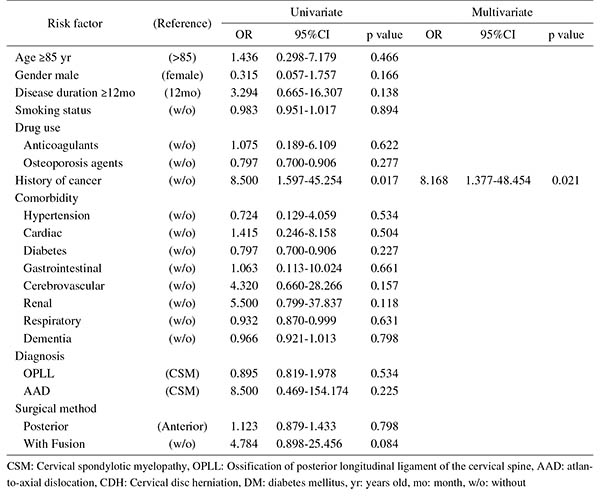- 著者
- Masaharu Kataoka Toru Satoh Hiromi Matsubara Koji Yamamoto Tsukasa Inada Kazunari Umezawa Tomohiko Takahashi Atsushi Nakano Keiichi Fukuda
- 出版者
- The Japanese Circulation Society
- 雑誌
- Circulation Reports (ISSN:24340790)
- 巻号頁・発行日
- vol.1, no.6, pp.268-275, 2019-06-10 (Released:2019-06-10)
- 参考文献数
- 15
- 被引用文献数
- 2
Background:This retrospective study was conducted to evaluate the safety and efficacy of ambrisentan combination therapy with phosphodiesterase type 5 (PDE5) inhibitors in Japanese patients with pulmonary arterial hypertension (PAH).Methods and Results:PAH patients who received ambrisentan for the first time in combination with a PDE5 inhibitor between January 2013 and the end of August 2015 were included in this study. Adverse drug reaction (ADR) safety analysis, as well as the efficacy analysis focusing on changes in clinical parameters, were investigated for overall cases and cases stratified by patient background. Forty-eight consecutive patients (n=21, 43.8% with idiopathic PAH; male/female, 18/30; average age, 43.3±17.4 years; World Health Organization functional class III/IV, n=22, 45.8%) who were treated with ambrisentan and a PDE5 inhibitor in Japan underwent the safety analysis. A total of 14 ADR occurred in 10 patients (20.8%). ADR included headache (8.3%), face edema (4.2%), angina pectoris (2.1%), hyperemia (2.1%), dyspnea (2.1%), pulmonary hypertension (i.e., worsening of PAH, 2.1%), nausea (2.1%), hepatic function abnormal (2.1%), edema (2.1%), and sudden death (2.1%). On analysis of hemodynamics parameters, there was a significant improvement in the mean pulmonary arterial pressure (−13.5 mmHg, P=0.0001) and pulmonary vascular resistance (−563.53 dyn·s·cm−5, P=0.0033).Conclusions:Ambrisentan combination therapy is safe and effective in hemodynamics improvement.
- 著者
- Koji Tamai Hidetomi Terai Akinobu Suzuki Hiroaki Nakamura Masaomi Yamashita Yawara Eguchi Shiro Imagama Kei Ando Kazuyoshi Kobayashi Morio Matsumoto Ken Ishii Tomohiro Hikata Shoji Seki Masaaki Aramomi Tetsuhiro Ishikawa Atsushi Kimura Hirokazu Inoue Gen Inoue Masayuki Miyagi Wataru Saito Kei Yamada Michio Hongo Kenji Endo Hidekazu Suzuki Atsushi Nakano Kazuyuki Watanabe Junichi Ohya Hirotaka Chikuda Yasuchika Aoki Masayuki Shimizu Toshimasa Futatsugi Keijiro Mukaiyama Masaichi Hasegawa Katsuhito Kiyasu Haku Iizuka Kotaro Nishida Kenichiro Kakutani Hideaki Nakajima Hideki Murakami Satoru Demura Satoshi Kato Katsuhito Yoshioka Takashi Namikawa Kei Watanabe Kazuyoshi Nakanishi Yukihiro Nakagawa Mitsunori Yoshimoto Hiroyasu Fujiwara Norihiro Nishida Masataka Sakane Masashi Yamazaki Takashi Kaito Takeo Furuya Sumihisa Orita Seiji Ohtori
- 出版者
- The Japanese Society for Spine Surgery and Related Research
- 雑誌
- Spine Surgery and Related Research (ISSN:2432261X)
- 巻号頁・発行日
- vol.1, no.4, pp.179-184, 2017-10-20 (Released:2017-11-27)
- 参考文献数
- 26
- 被引用文献数
- 3 3
Introduction: With an aging population, the proportion of patients aged ≥80 years requiring cervical surgery is increasing. Surgeons are concerned with the high incidence of complications in this population, because "age" itself has been reported as a strong risk factor for complications. However, it is still unknown which factors represent higher risk among these elderly patients. Therefore, this study was conducted to identify the risk factors related to surgical complications specific to elderly patients by analyzing the registry data of patients aged ≥80 years who underwent cervical surgery.Methods: We retrospectively studied multicenter collected registry data using multivariate analysis. Sixty-six patients aged ≥80 years who underwent cervical surgery and were followed up for more than one year were included in this study. Preoperative patient demographic data, including comorbidities and postoperative complications, were collected from multicenter registry data. Complications were considered as major if they required invasive intervention, caused prolonged morbidity, or resulted in prolongation of hospital stay. Logistic regression analysis was performed to analyze the risk factors for complications. A p-value of <0.05 was considered as statistically significant.Results: The total number of patients with complications was 21 (31.8%), with seven major (10.6%) and 14 minor (21.2%) complications. Multivariate logistic regression analysis, after adjusting for age, revealed two significant risk factors: preoperative cerebrovascular disorders (OR, 6.337; p=0.043) for overall complications and cancer history (OR, 8.168; p=0.021) for major complications. Age, presence of diabetes mellitus, and diagnosis were not significant predictive factors for complications in this study.Conclusions: Preoperative cerebrovascular disorders and cancer history were risk factors for complications after cervical surgery in patients over 80 years old. Surgeons should pay attention to these specific risk factors before performing cervical surgery in elderly patients.
